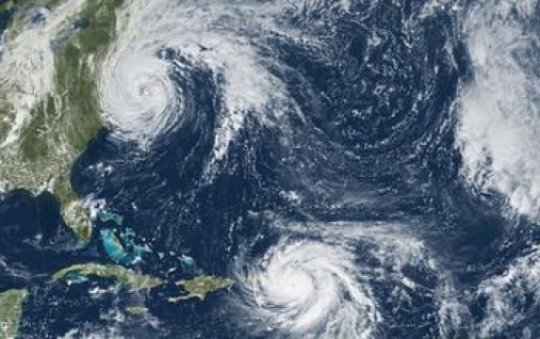[ad_1]
The availability of water from underground aquifers is vital to the basic needs of more than 1.5 billion people worldwide.
In recent decades, however, the over-pumping of groundwater, combined with drought, has caused some aquifers to permanently lose their essential storage capacity.
With the hope of providing better tools to water resource managers to keep aquifers healthy, scientists funded by the National Science Foundation (NSF) and affiliated with Arizona State University (ASU) and the Jet Propulsion Laboratory (JPL) are using the latest space technology to measure this precious natural resource.
“Periods of drought have long-term effects on groundwater supplies and create major challenges for groundwater management,” says Maggie Benoit, a program director in NSF’s Division of Earth Sciences, which funded the research. “Now, scientists are developing new methods of monitoring groundwater levels using satellite-based measurements of Earth’s surface, providing a more comprehensive picture of the health of our nation’s groundwater resources.”
The researchers have focused their efforts on one of the world’s largest aquifer systems, located in California’s Central Valley, measuring both its groundwater volume and its storage capacity. The results of their findings are published in the American Geophysical Union journal Water Resources Research.
Peering underground from space
California’s Central Valley is a major agricultural hub covering an area of about 20,000 square miles. It produces more than 25 percent of U.S. agriculture, at an estimated value of $17 billion per year.
The Central Valley aquifer system provides water for people and wetlands, supplying about 20 percent of the overall U.S. groundwater demand. Because of drought and the increase in the human population this aquifer serves, it is ranked one of the most stressed in the world.
While past studies on water resources and drought have focused mainly on low-resolution or local scale measurements of groundwater dynamics, the research team for this study, which includes ASU scientists Chandrakanta Ojha, Manoochehr Shirzaei and Susanna Werth, and Donald Argus and Thomas Farr from JPL, took a more high-tech route.
They used the data collection features of several satellite-based Earth remote sensing techniques to obtain a more consistent and higher resolution view of the Central Valley aquifer system.
“Ironically,” says Werth, “we had to go several hundred miles into space to see what was going on under the surface of our planet.”
Using these high-tech, remote-sensing techniques, the team analyzed data from the 2007 to 2010 drought and mapped the entire California Central Valley.
“It’s great when we can use our high-tech, Earth-orbiting satellites to help solve real-world problems right here in California,” adds Farr.
An indicator for aquifers around the world
The team measured land subsidence (when land above and around an aquifer shifts downward) using space-borne Interferometric Synthetic Aperture Radar (InSAR) and added that to data on groundwater levels sampled at thousands of wells across the Central Valley.
The researchers then used data from NASA’s twin satellite mission, the Gravity Recovery and Climate Experiment (GRACE), to estimate groundwater loss.
“It’s this combination of literally terabytes of data that helped us get the best picture of what is happening below the surface,” says lead author Ojha.
The team found that between 2007 and 2010, there was a significant drop in ground levels in the southern area of the Central Valley — nearly 32 inches, a decrease that should normally take decades.
“Groundwater overdraft in some parts of the Central Valley has permanently altered clay layers, causing rapid ground sinking that can be measured by radar satellites from space,” says Shirzaei.
The most startling result, however, is the permanent loss of water storage capacity in the aquifer system. During the 2007 to 2010 drought, up to 2 percent of storage capacity was lost entirely when the water level declined and the clay layers in the system were permanently compacted.
“That storage capacity cannot be recovered through natural recharge,” says Ojha. “This means that during the wet season, when the Central Valley gets rain, there is not enough space to store the water, making groundwater supplies more scarce during future droughts.”
New satellites to measure the effects of drought
The next step for the team will be to focus on the drought in California from 2012 to 2016, a period that was more detrimental to the Central Valley aquifer than the 2007 to 2010 drought.
The researchers plan to integrate radar measurements with additional data from the newly launched GRACE Follow-On (FO) satellites.
The GRACE FO mission, which launched on May 22 of this year, consists of two nearly identical satellites that follow one another along the same orbit. The satellites continually measure the distance between them, which changes depending on the gravity field over which they are orbiting.
Since oscillations of groundwater change the gravity field, scientists can use the data to map underground water location and volume change.
The work will not end there. The team hopes to extend the research to Arizona and other areas of the arid Southwest.
“The whole region is affected by a long-term drought,” states Werth, “with differences in severity, climate conditions, groundwater geology and water management approaches.
“Our hope is that this research will enable decision-makers to accurately manage water resources and plan for future water allocations. Water managers need to know about the irreversible processes taking place and how to prevent future crises.”
[ad_2]















